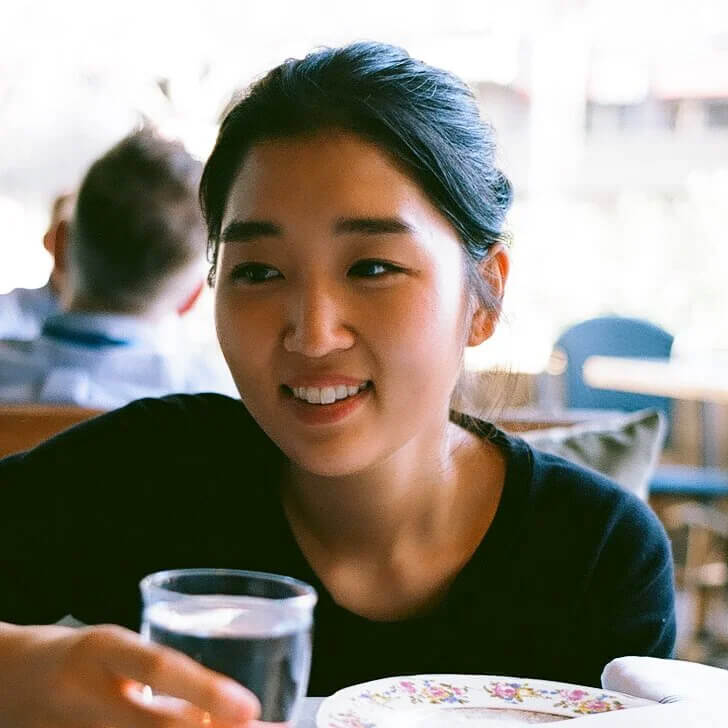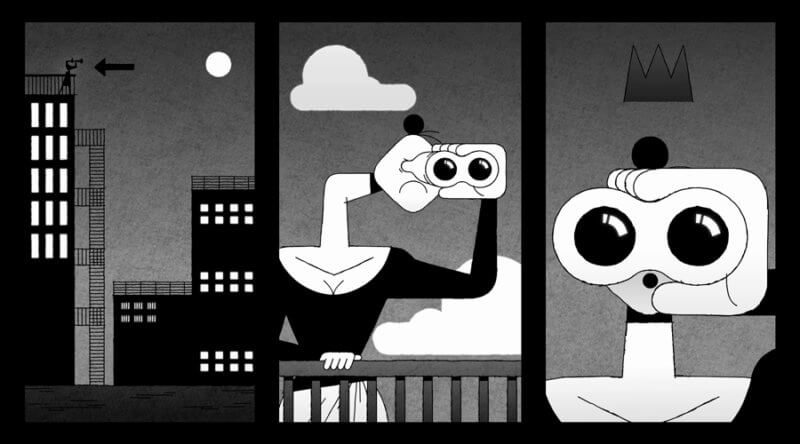Q&A with Erin Kim (‘Revenge Story’)
A graduate of California Institute of the Arts, during which time she made the several short films including Ear Fear (2015) and cycles (2016), LA-based storyboard artist/animator Erin Kim has since produced work for Cartoon Network, Capitol Records, Moving Colour and Storybots Inc. As well as self-started illustration and comics work including the web series Zero Empathy Boi, Erin recently completed her first independent short film Revenge Story, in which a mangled ballerina seeks revenge on the chiropractor she blames for ruining her career.
Featuring striking and impressive design work and a darkly witty edge to its storytelling, Revenge Story has screened at events such as Pictoplasma and Spark Animation Festival as well as our own upcoming Skwigly Screening at the Manchester Animation Festival. We spoke with Erin about her work so far, the challenges of taking on an independent short and her hopes for the future.
Can you tell us a bit about your background and early artistic interests that ultimately led to your work as an animator?
I was born in Seoul, South Korea, and then I immigrated to Canada when I was 11. Growing up, I read Japanese manga and watched anime a lot. When I wasn’t fluent in English, I spent so much time by myself drawing and watching anime, because I couldn’t fit into the new environment. I did watch western animated films and TV shows as a kid but it was only during my late teen years that I finally started appreciating Disney films. Now as a professional, I realise that my core humour and visual style comes from the old manga and anime I was exposed to, but I utilise more western principles when it comes to creating a film.
What drew you towards studying at CalArts, and can you talk a bit about the work you produced during your time there?
I was drawing all the time since I was a little kid, and it was clear to me that I was going to become an artist. Both of my parents encouraged me to pursue my artistic dreams. I didn’t fully understand how big of a deal it was to go to CalArts until I got accepted. In fact, I didn’t know that I had to make a film every year.
My first year film was called Onion, and it was about a stinky onion who can’t find any vegetable friends. At the end, the onion finds other stinky veggies, and they have a pan frying party. I still like the story. For my second year, I made a film called Bugged, and it was a typical “chase film”. I met the deadline but the film itself was so boring and unsatisfying.
During my 3rd year, I made a film called Ear Fear. It was about a character who switches his animal ears to fit into the environment he is in, but ultimately accepts himself, for his love and for his own good. The film definitely reflects my personal experiences that I was going through.
My 4th year film cycles was about a young cyclist who was going through a family problem. I tried to focus on little personal goals which were telling a personal story, and having dialogues. It was definitely challenging. Each year I tried to avoid making the same mistake that I made in the previous year.
Overall, making four films made me as a mentally strong artist, and I’m glad that I tried something new every year. As stressful as it was, I loved making short films, and that’s why I still make personal short films.
Despite dubious criticisms (e.g. prevalence of ‘the CalArts style’ as a derisory term), CalArts’ student output spans an enormously diverse range of artistic approaches. From your perspective as a recent graduate did you find that the school encourages students to pursue an individual artistic direction?
Yes, I understand what the “CalArts style” looks like. But I think that you see that style often because it’s a simple industry standard style, especially for TV shows. The simplified, round, and quick to draw style is just more economical for production.
However, I felt that the school definitely taught a specific way of storytelling. Story classes felt very formulaic. If you tried something different or a little abstract, not that many people understood the value of experimenting. That being said, I do appreciate the story classes teaching me how to build a story. In fact, CalArts supports students when it comes to finding a job at a studio, and teaching the industry knowledge. And maybe an individual artistic direction unfortunately is not as important if someone’s goal is to find a job at a studio, because studios want to see specific things. This is a loaded question, haha.
Since graduating is your hope to primarily direct or are their other areas that hold appeal?
It took me a long time to realise that I like storyboarding and writing. For a long time I was more of a “generalist” who did everything. But now I want to focus on storytelling, and ideally I would like to have my own TV Show.
What prompted you to make Revenge Story? Was it made alongside or between jobs?
Revenge Story is also inspired by my personal experiences. It’s about moving on from a life event, because dwelling on the past only hurts you even more. Also, I just love revenge as a concept.
I made the film alongside my day job. I had a crazy schedule of waking up at 6:30am, and working for a few hours before the day job. After the day job ended, I stayed at work longer to continue working on my film. It took me about a year and a half to complete everything, and it was tiring and painful.
Visually it stands apart from a lot of your prior work in the starkness of the design style and lack of colours. Can you discuss how you developed this style and why you wanted to make something so distinct?
Each film needs its own look! I was heavily influenced a manga series called Sayonara Zetsubou Sensei, and the series had such clear silhouettes and minimal design choices. I love flat and graphic designs. And to be honest, I don’t think I understand colour that well so I just wanted to avoid any elaborate colours or lighting. I know my limits now so it’s about showing what I’m the best at, while hiding my weaknesses.
I’m always interested in how artists overcome the practical realities of independent animation and how those vary depending on a multitude of factors – location, resources, time etc. Can you talk a bit about the overall production process and how you were able to bring the film together (and what sort of challenges there may have been along the way)?
The struggle is real. I storyboarded, designed, animated, and composited everything by myself. The one woman show was something that I was used to, since I made films at CalArts. But hiring a professional sound designer and composer was a new experience. My composer also recommended me to go for hiring an orchestra, so we recorded the score at Capitol Records. Funding everything by myself was hard, but at the same time I didn’t want to ask for free labour from my collaborators.
While Revenge Story is ostensibly a comedic, slapstick work it did seem to me to carry with it a simple but important message about the dangers of obsessing over setbacks rather than working through them. Was the story prompted by anything in particular?
I’ve watched many animated films where things go wrong, but in the end everything is magically solved. I have had issues with stories like that. Most of the time I couldn’t fully relate to those films because, often some things cannot be reversed or fixed. We regret and obsess over things that happened in the past. In fact, it takes years to get over a bad experience. I wanted Revenge Story to be about the struggles after what one has gone through, and eventually coming to a conclusion of moving on, but not undoing the damage that has been done.
You’re also very active in online illustration and webcomics – does this work draw on the same creative impulses or are they a separate beast from your moving image work?
The birth of my webcomics are kind of related to Revenge Story. When I started animating Revenge Story, I wanted to start promoting my work online more. But it felt like the film production was progressing very slowly and I had nothing to share. So I started making 1 or 2 panel comics talking about the mental struggles I was going through at the time. The initial intent of my art Instagram was to create more daily contents that are easy to produce. Now it has become its own thing and my comics take such a long time to make, ha.
View this post on Instagram
Do you see yourself expanding on the webcomic work through animation in the future?
I’m trying to turn my Zero Empathy Boi series into a TV show. First I would like to make some short clips with puppet models!
By and large your work tends to tackle themes of internal conflicts and anxieties, something animation can serve as a powerful communication tool for. What sort of responses have you gotten from your films/art, and are these themes you plan on continuing to explore?
I’m very thankful for the people who leave a long comment reacting to my films/comics saying how much they related to my story. The personal stories I hear back from the audience is one of the reasons I make my art, they are my emotional support. It’s very fascinating to me that people with completely different backgrounds somehow find my work, and they feel like my work speaks for them.
I love internal conflicts because I have so many of them. Maybe it’s obvious that I’m interested in psychology. I started reading Carl Jung books, and the idea of “unconscious” intrigues me a lot. The concept of the “undiscovered part of you” seems like a thought provoking theme to explore, since everyone is somewhat unaware of themselves in certain areas.
Is there anything you’re working on now that you can tell us about?
I’m currently working on my webcomic series Zero Empathy Boi. It’s about a boy with no empathy, who wants to be liked by everyone. I’m creating a zine style comics, but also coming up with TV show episode ideas for a pitch. It’s still at an early development stage, but I’m very excited!
Revenge screens this Wednesday November 13th as part of our Skwigly Screening at the Manchester Animation Festival, 5pm at HOME.
See more of the work of Erin Kim at erinkimart.tumblr.com



